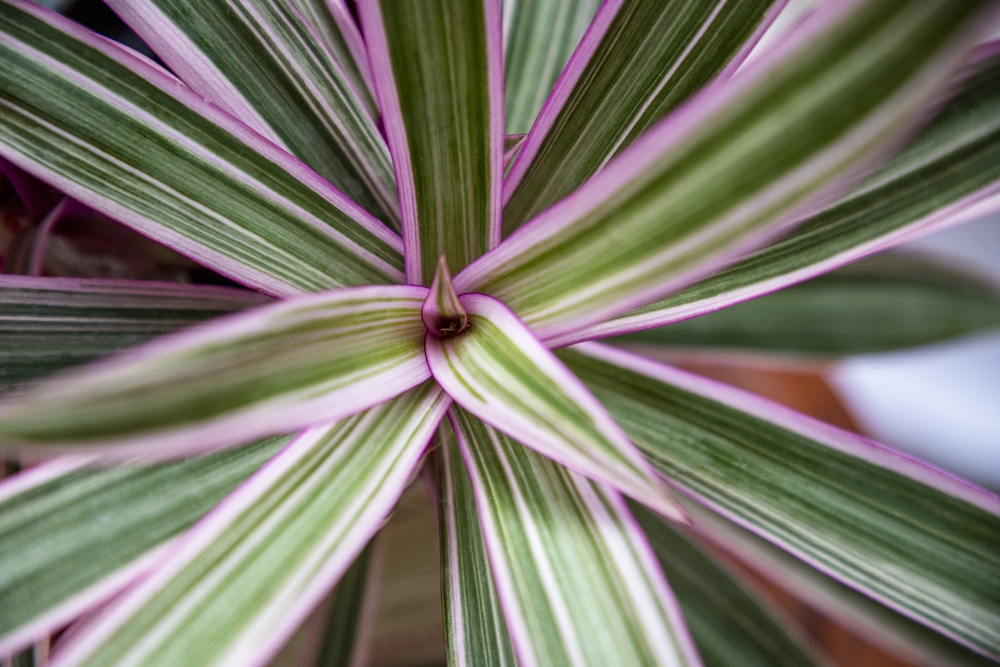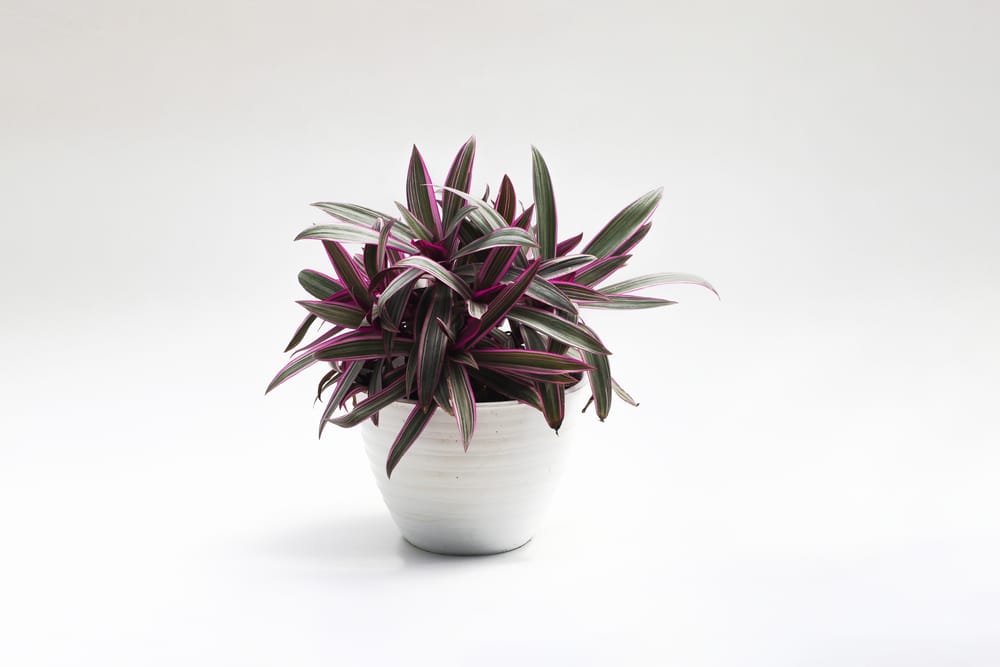Moses-in-the-cradle, often referred to as the oyster plant or by its Latin name, tradescantia Spathacea, is a beautiful and highly prized indoor house plant found frequently in many big box stores and smaller nurseries.
This interesting and unique species bears groups of thick, green and purple leaves, with accents of tiny white flowers at the bases of each node when it flowers. There are several species that can have been cultivated for indoor growing, but Spathacea is by far the most popular and beloved.
Aside from being an attractive purple-accented houseplant option, Moses-in-the-cradle is fairly easy to care for. It’s a great plant for any beginners who have bright light in their space, and will provide plenty of opportunities to make starts for sharing with friends and family.
Overall, Moses-in-the-cradle is one of the most adaptive and fun plants to grow when it comes to fun, unique indoor plants.

Origin and History of Moses in the Cradle
While still remaining a popular houseplant option today, this plant has a very long history. It was discovered by John Tradescant, hence its name, back in the 16th century AD.
These days, this plant is found globally, and is even considered an invasive species in some regions due to humans planting them outdoors for landscaping and gardening purposes.
The hardiness of this plant makes it easy to grow almost anywhere warm, except where frost is prominent each year.
This species is native to parts of Mexico and South America, though now it is found growing wild in tropical and subtropical regions of the U.S. and Africa.
Its journey around the world can be attributed to its beauty; plant collectors globally have sought out and traded this plant for many centuries, and it will likely continue to be one of the most heralded naturally purple plants on the market.
Moses in the Cradle Care
Caring for one of these plants might look difficult, but it’s actually quite simple. Moses-in-the cradle prefers growing conditions very similar to most topical houseplants, so if you’ve had success with other tropical species in your space, this one will likely do quite well.
However, if you’re a beginner, Moses-in-the-cradle is a great plant to start your journey into indoor gardening, especially with its forgiving nature and will to survive in drought conditions.
Growth Habits
Like many plants, Moses-in-the-cradle will happily grow all year long, but it has growing seasons and flowerings seasons, as well.
Depending on where you live, your plant will likely put on new growth throughout the spring and summer, and will flower in early to late summer. If you live in a warmer, brighter climate with more annual sunshine, these seasons could be earlier and/or longer.
Each year, new starts will grow in the pot, so it’s important to keep them from getting too crowded.
Light Requirements
As you might have already guessed, this plant does need quite a bit of light to maintain its rich purple hues. The more light Moses-in-the-cradle gets, the more purple it will appear. Too much or unfiltered light can leave burn spots in the leaves, though, so avoid placing them right in a bright windowsill and opt for nearby placement instead.
If you don’t have lots of sunshine in your region, try using an artificial light source to help boost the plant’s health. Ideally, you should aim for 6-10 hours of bright, indirect light each day for optimal growth and reproduction. If your plant begins to look more green under the leaves than purple, then it’s time to add more light.
Water Schedule
Being native to hot and dry climates means overwatering should be avoided at all costs. It’s better to under-water than over-water with this species, but if you over-water once or twice a year, it’s likely no big deal.
On that note, if you forget to water your plant for a week, it will be okay as long as it’s normally watered on a good schedule.
Try starting with twice per week, saturating the soil and letting it drain out entirely.
From there, you can easily gauge whether you need to water more or less based on how damp the soil is when it’s time to water again. The top two inches of soil should be relatively dry before rewatering.
Temperature and Humidity
Moses-in-the-cradle is native to hot climates, but it doesn’t need ninety degrees all day every day to happily thrive. In fact, anywhere in the range of 60-80 degrees is best, so long as temperatures do not stay at either end for long periods of time.
If you keep your house at 70 degree fahrenheit most of the time, that’s perfect. However, this plant doesn’t tolerate cold well, and will quickly wilt if exposed to frost or freezing temperatures.
Keep this in mind when winter months come rolling around, and be sure that your plant isn’t too close to any windows, which can get too cold for most indoor plants in colder climates.
Soil and Potting
Soil is key to a healthy moses-in-the-cradle. For this plant, any soil with sand and vermiculite or perlite will suffice, but soils with too much peat will be too acidic. Y
ou can either mix your own soil based on these ingredients and with added humus, or you can purchase a pre-made soil blend from a store that’s formulated for tropical and indoor plants. Paired with a well-draining container, soil can last from 6 months up to a year depending on the growth of the plant and quality of the soil.
Repotting should take place at least once per year to prevent this fast-growing plant from crowding itself out.
Fertilizing
In its natural habitat, Moses-in-the-cradle is exposed to lots of nutrients from humid conditions and rainfall washing decomposed vegetation into the soil. While this is just the ideal growing condition for this plant, treating it similarly to most houseplants in terms of fertilizer is generally enough.
Moses-in-the-cradle should be fertilized with a balanced fertilizer once every six months for warmer regions, and every ten months for colder regions with less sunlight.
You can use either a natural fertilizer (free of pesticides) or you can use any number of fertilizers formulated for indoor or tropical plants.
Pruning
As this purple and green gem grows in a rosette from a cluster of widespread roots, it forms new starts from the soil surrounding the mother plant that each grow into a new plant. These plants will all remain connected to each other until you separate them.
To do this, you will need to entirely unpot the plant, which is covered in the next section, and gently separate each plant by carefully moving them apart in a circular motion. This helps to break the roots up without damaging them, especially if the soil is damp.
Cut each stem away at the base with a clean, sharp, blade, and repot into a new container! You can then plant the mother plant back in its original pot, or you can leave some starts on it for a lusher appearance and repot it into something bigger.
Repotting
To repot a Moses-in-the-cradle, it’s important to first consider the delicate root system that may be bound into its current container. Loosening these roots without damaging them is the ultimate goal; however, some roots will need to be removed if there is no way to detangle them.
Moistening the soil before removing the plant from its pot will help to soften the roots and make them more flexible and less likely to break. To avoid stressing the plant out, you’ll want to use the tips of your fingers to help break the roots loose at the bottom, then plant it in its new container, which should be slightly larger than the one it just came from and filled ⅓ of the way with soil.
Once you’ve set in the plant, fill in the surrounding space with soil, and you’re all set to water for the first time!
Toxicity
Unfortunately, Moses-in-the-cradle can be irritating to the skin upon contact and toxic if consumed by humans and pets.
To help avoid accidental plant toxicity or exposure, keep this one up and away from any curious little ones, and in a location where it’s unlikely to hit the floor with a slight bump. Another way to keep everyone safe is to place your plant in a closed-off or otherwise inaccessible area of the house, such as a room or den.
If you don’t have any places to keep one in your home, Moses-in-the-cradle also makes a fabulous office plant!

Pests & Disease
In a perfect world, every houseplant that comes home from the supermarket or nursery is pest-free and healthy as can be. However, in this world, we can unexpectedly bring all sorts of nasty creepy crawlies into our homes and our houseplants.
This is nearly unavoidable if you can’t stop buying them, but can be treated efficiently at home with a few basic household products, and some you may need to go out for.
The two primary pests that are most likely to be found on Moses-in-the-cradle are spider mites and the ever-irritating mealybugs. Spider mites can be eradicated with a daily hosing down of water, which prevents them from building homes on a plant, or sprays including gentle soaps and neem oil.
Mealybugs are a bit tricker, and will persist if you let your guard down for even a day. The most effective yet time-consuming way to eliminate these pests is to soak a cotton swab in rubbing alcohol, then rub down each insect you find on the plant every day until you haven’t seen one in over two weeks and the plant looks healthy again.
Aside from these more traditional methods, you can also purchase environmentally-friendly pesticides that are safe for indoor use around your home, and won’t harm children or pets.
Always double-check labels to make sure the product you choose is safe, and follow the directions on each label; some sprays are different than others. With consistent treatment and follow-through, it is possible to rescue an infected plant from these common invaders.
Frequently Asked Questions
With all plants, there’s a wealth of knowledge that comes with experience. If you’re a beginner, it might be a little intimidating to learn that plants need so much attention, but once you get the hang of it, Moses-in-the-cradle is relatively low-maintenance and fun to grow. Whether you’re a beginner or an experienced crazy plant person, there’s always something else out there to learn about plants, especially those as unique and colorful as this one!
Why are my moses-in-the-cradle’s leaves turning brown?
A: Sometimes, moses-in-the-cradle can be finicky in different environments. Browning leaves or leaf tips can be a sign of a few things. The first is that it receives too much or too direct light each day, which can burn the leaves and cause spotting and brown, crispy tips. Another common issue is overwatering. If the plant is allowed to sit in stagnant water, its roots may begin to decompose, which restricts the plant from absorbing water and nutrients. To remedy this, allow the plant’s soil to dry halfway through the top of the pot before watering again. The last but less common problem is acidic soil. Soil that hasn’t been changed in over a year will break down into a nutrient-lacking, dense and clogged soil that prevents any water or airflow from reaching the roots of the plant. Soil should be in different-sized chunks when picked up from the pot.
Why is my moses-in-the-cradle more green than purple?
A: In order to produce the deeply colored pigments that make its leaves appear a purple hue, moses-in-the-cradle needs lots of sunlight. Green leaves that show relatively little or no purple or devoid of sunlight, and should be placed closer to a bright window or near an artificial light source, such as a full-spectrum LED grow light. Once it’s been exposed to bright light for a few days, the purple hues will slowly begin to creep back into the leaves, and new leaves will have more prominent purple coloring.
Why does my moses-in-the-cradle look dull?
A: Ideally, moses-in-the-cradle lives in a moist, humid environment where the air contains lots of moisture. If you live in a typical household, however, it’s likely that your space is much more dry than a tropical rainforest. Dull leaves can indicate that the plant isn’t getting enough humidity, which can easily be remedied by a daily misting or fine droplets of water, or by placing a humidifier nearby. You can also simulate added humidity by placing the container over a tray of pebbles filled with water. The pebbles will help the water evaporate, creating a tiny bubble of humidity for your moses-in-the-cradle.


One of the stems broke off my moses in the cradle. Do I put it in water or dirt?